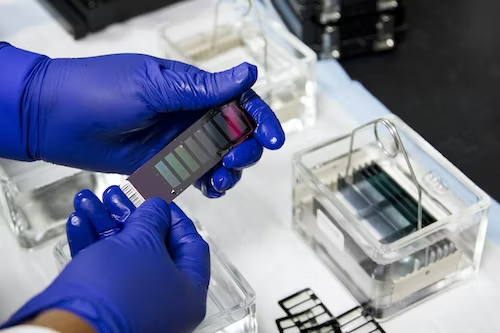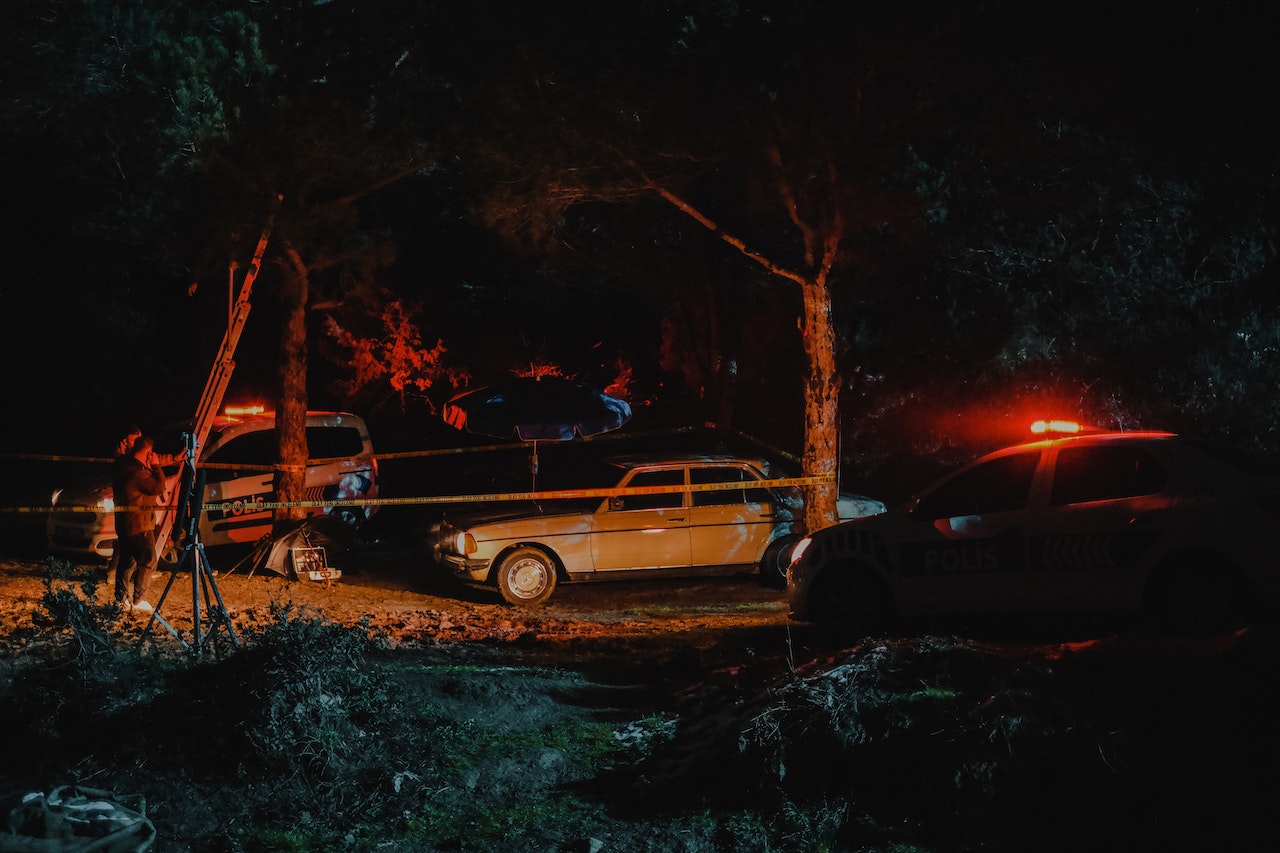Forensic DNA Expert Q & A
Dr. Dean Hildebrand received his Ph.D. in 1996 from the University of British Columbia’s Department of Biochemistry and Molecular Biology. His knowledge of molecular biology stems from his graduate research and practical experience gained as a Post-doctoral Fellow and Research Associate.
Dr. Hildebrand is currently the Associate Dean for the Computing, Chemistry and Forensics departments. Prior to that he has held faculty and director positions within the Forensics department at BCIT and is a recognized expert in the field of forensic DNA analysis. His work focuses on the recovery and analysis of DNA from degraded remains using STR’s, mini-STR’s, Y-STR’s and mitochondrial DNA for the purposes of human identification.
The laboratory Dr. Hildebrand helped establish at British Columbia Institute of Technology BCIT is called upon by local and international Coroner and Police agencies to assist in challenging casework where human identification is required. He also works as a consultant for the B.C. Coroners Service (Special Investigations Unit) as a subject matter expert in forensic DNA analysis. In this capacity he helped develop and now maintains the unidentified remains and missing person DNA database for the province of British Columbia.
Want To Study Forensics/CSI?
You were quoted in an article for CBC news as saying that the science of Forensic DNA is all about connections. What do you mean by this?
Connections, or associations, are ultimately the goal of a forensic expert regardless of the discipline. For example the fingerprint expert strives to associate a fingerprint found at a crime scene (called a "latent print") to that of a reference fingerprint collected from a known individual. This individual may be a criminal, convicted previously and whose print is on file in the national database. Or the forensic dentist associates the teeth of suspect to the bite mark pattern left on the skin of his/her victim (note, we have seen the opposite of this also, where the expert must associate the teeth of the victim who, in self defence, bit their attacker).
These are two common examples of forensic associations and they are very intuitive, easy for the lay person (juror) or trier of fact to comprehend. We all understand the concept of a greasy fingerprint (we see them every time we wash our glasses) or the marks left by teeth when we bite an apple. This inherent intuitiveness is somewhat lost when we discuss a forensic DNA comparison but the concept is exactly the same - even if the technology is a bit of a "black box". We must associate a questioned or unknown biological sample to that of a known source (or reference sample). For example, DNA from a vaginal swab from a rape victim to that of her attacker. Or DNA from a skeleton to that of his mother for identification purposes.
In your experience, what would you say are the most common uses of DNA within a forensic context?
One can divide DNA cases into two broad categories, each of which can be further broken down: criminal and civil matters. Criminal cases often involve the comparison of crime scene samples to that of suspects (our national DNA database for example have a "crime scene index" and a "convicted offender index"). The identification of a deceased individual can span both categories (for example one of the first steps of a murder investigation is the identification of the victim). However, a natural sudden death may require the exact same approach to produce a positive identification and death certificate from the coroner for insurance purposes, estate matters, etc.
|
Civil matters can also cover issues related to paternity and immigration and these probably represent the majority of DNA testing conducted with an entire industry built on addressing these questions. There is also the obvious humanitarian role DNA identifications plays in society for the relatives of the deceased. |
|
The laboratory you helped establish has the latest technology for DNA-based human identification. In forensic terms what does this latest technology allow you to do compared to say 5 or 10 years ago?
The technology hasn't changed too much in the last 10 years because for a national system (like the RCMP or FSS) to change and implement a new technology requires an incredible amount of research, validation and roll out to the operational sections across the country. Canada, like everywhere else, went to short tandem repeats (STR's) in the 1990's and we still utilize these very informative DNA markers for human identification.
As mentioned above, our national DNA database was also established with this technology. That's not to say that there have not been some important improvements. For example we now have much better technology for detecting and quantifying human DNA, an important step prior to the amplification and analysis of STR's. We now use a "real-time PCR" method as opposed to tedious, semi-quantitative "slot-blots". There have also been improvements in the technology used to visualize the STR's after amplification - so-called genetic analyzers. These sensitive and expensive instruments utilize a "capillary electrophoresis" method and can allow very high throughput. At the front end, most large labs now utilize a robotic approach for routine DNA extractions so there is less need for manual DNA extractions.
What would you say are the most important areas within forensic DNA research and development today?
You will soon see more use of mini-STR systems for challenging cases where DNA amount is limiting or degradation is an issue. These are similar to conventional STR's but they target smaller pieces of DNA for amplification. Our lab at BCIT utilizes AmpflSTR MiniFiler, a commercial mini-STR kit from Applied Biosystems. It has had an immediate positive impact for the challenging casework we do for the BC Coroners Service.
One of the most challenging aspects of a forensic DNA comparison is mixture interpretation. Mixtures are very common in case work and can run the gamut from straightforward to extremely complex and time consuming. Different laboratories have different approaches to mixture analysis and there is no standardized approach. We are starting to see the development of better software packages to assist the expert in these deconvolutions.
Many forensic scientists have expressed concern over the distortion between fictional portrayals of forensic science and the application of forensic science in the real world. Do you think that these distortions exist in relation to DNA identification and analysis? If so, in what way? And should we be overly concerned that these distortions exist?
The "CSI Effect" was a term coined several years ago based on the extremely popular fictional TV show -"CSI". This has been a double edged sword. Forensic programs around the world saw the benefit of this free marketing with an influx of students interested in a career in forensics. Some walked away immediately, disillusioned by the realities of true life forensics, which can be mundane at times. But many stayed and have gone on to become experts in their own right.
In the courtroom the CSI Effect is also well documented. Jurors have developed an unrealistic expectation of what should be presented in a trial. When forensic evidence, like DNA for example, is not present the case can be weakened in their minds. This can minimize or negate some incredibly valuable information garnered from hard work by the investigators and Crown.
In addition, the lay person must realize the limitations of DNA. Although it can provide very strong evidence with respect to an association between a piece of evidence and a suspect, it does not tell you WHEN this association took place. I recall an armed robbery case that I assisted on that had extremely strong evidence to associate some discarded clothing to the suspect (left behind at the scene). The defence successfully argued that the DNA was admittedly his client's but he did not deposit the DNA on the clothing during the robbery. Rather he did so a week earlier when he used the same piece of clothing at his buddy's house during some drug manufacturing activities. There was some indication that this buddy had supplied disguises to some individuals for the commission of a robbery - perhaps the one in question? So even when the DNA evidence is as good as it can get, it still must be interpreted within the context of the case.
The Q & A section of the All About Forensic Science website regularly receives submissions relating to forensic scientists and forensic experts. Can you help illuminate any of the following common themes?
MOST INTERESTING/FASCINATING CASES WORKED ON
Tough question after 100's of cases. Early in my career I worked in a forensic odontology laboratory and saw some fascinating (and tragic) cases. I recall a female murder victim that was found bound up into a ball and frozen solid in a small freezer. It was the first time I had ever seen a knot expert ply his trade. He was called in because of the unique rope and knots utilized by the killer.
More recently the "floating feet" has been a really challenging and interesting process. Almost 3 years ago the first foot was found washed up on shore. Since then 6 others have been found.. Most are still unidentified and the work continues by are a variety of forensic experts.
MOST REWARDING ASPECTS OF THE JOB
The work I am currently doing with the Coroners Service has been very rewarding. I am a forensic DNA consultant for their Identification and Disaster Response Unit. Within that capacity I and an IT colleague developed the provincial unidentified remains / missing persons DNA database. This DNA database, with a humanitarian mandate is the first of its kind in Canada for a Coroner or Medical Examiner's office. It has allowed the BCCS to make some identifications that may not have otherwise occurred, at least not as quickly. How it works - DNA profiles from unidentified remains are entered and compared against other sets of remains in order to consolidate partial remains cases. They are then compared against all the known profiles to make an identification. The Coroners collect samples from family members of missing persons as well as personal effects for use as reference DNA samples.
BEST PIECE OF ADVICE FOR THOSE SEEKING A FORENSIC CAREER
Forensics is a fascinating career but can be difficult to break into given the amount of interest (and relatively few positions). My advice really depends on one's end goal in terms of a career and there are MANY types of careers. If for example you wish to work in a forensic laboratory you will need a Bachelor of Science and your chosen specialty will depend on what area of the lab you want to work (biology, chemistry, etc).
Adding specialized training in forensic science is a good way to set oneself apart from the student who just has their basic sciences. Be ready to compete. Make sure you network (join forensic societies, academies etc and go to the meetings). Be flexible with respect to geographical location and starting position. Good Luck !
CLICK HERE To Visit The British Columbia Institute of Technology (BCIT) Centre for Forensic and Security Technology Studies.
Recent Articles
-
The Role of Forensic Evidence in Car Accident Investigations
Jan 30, 24 07:22 AM
Insightful article on the role of forensic evidence in car accident investigations. -
The Role of Forensic Science in Personal Injury Cases
Oct 20, 23 03:56 AM
Insightful article on the role of forensic science in personal injury cases. -
All About Forensic Science
Aug 16, 23 09:53 AM
A forensic science website designed to help anybody looking for detailed information and resources.



New! Comments
Have your say about what you just read! Leave me a comment in the box below.